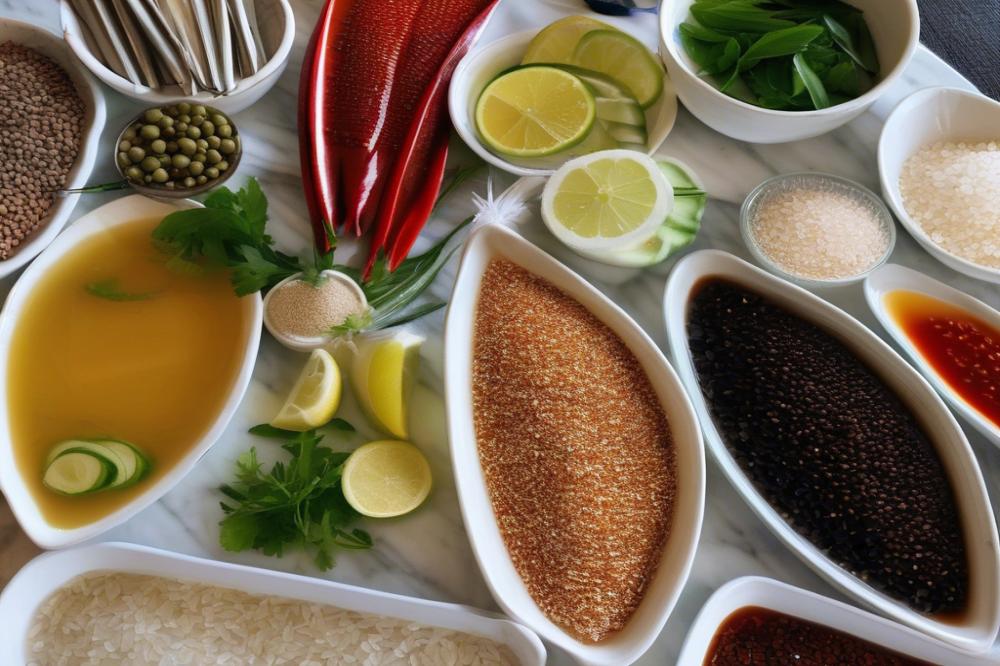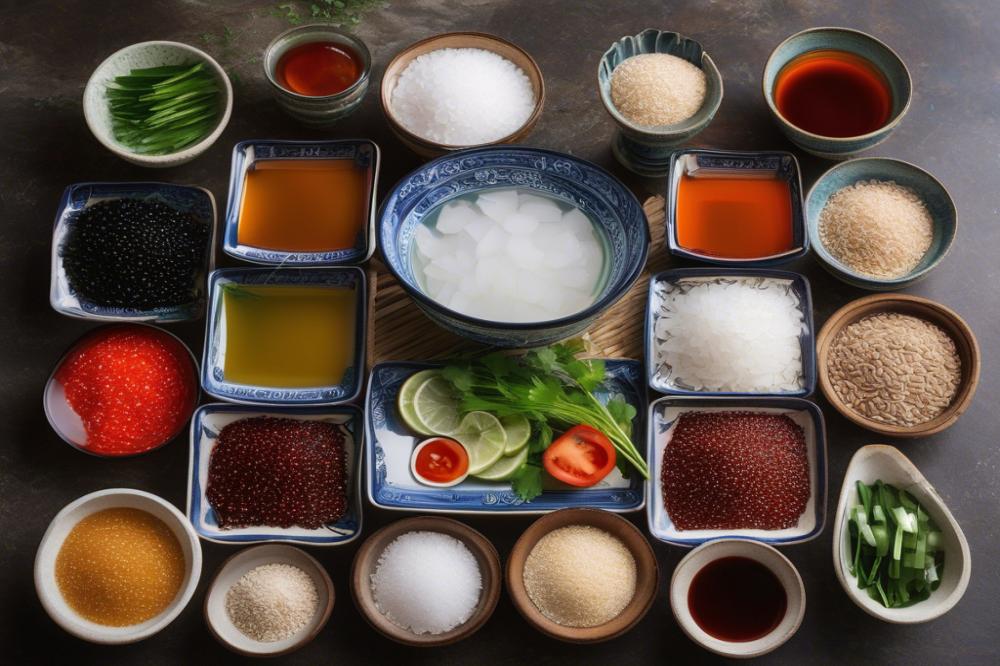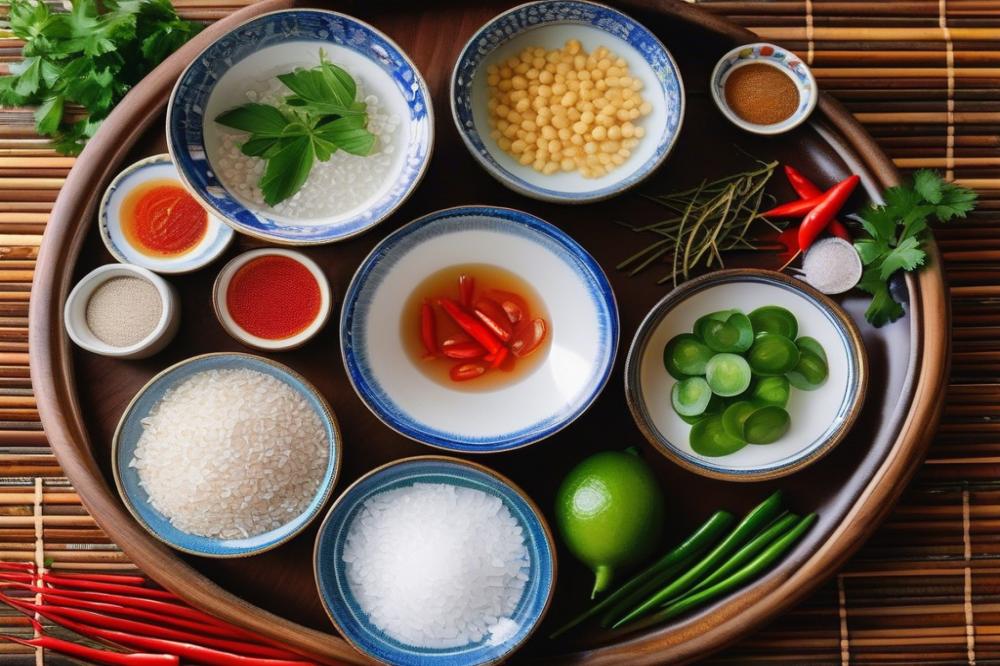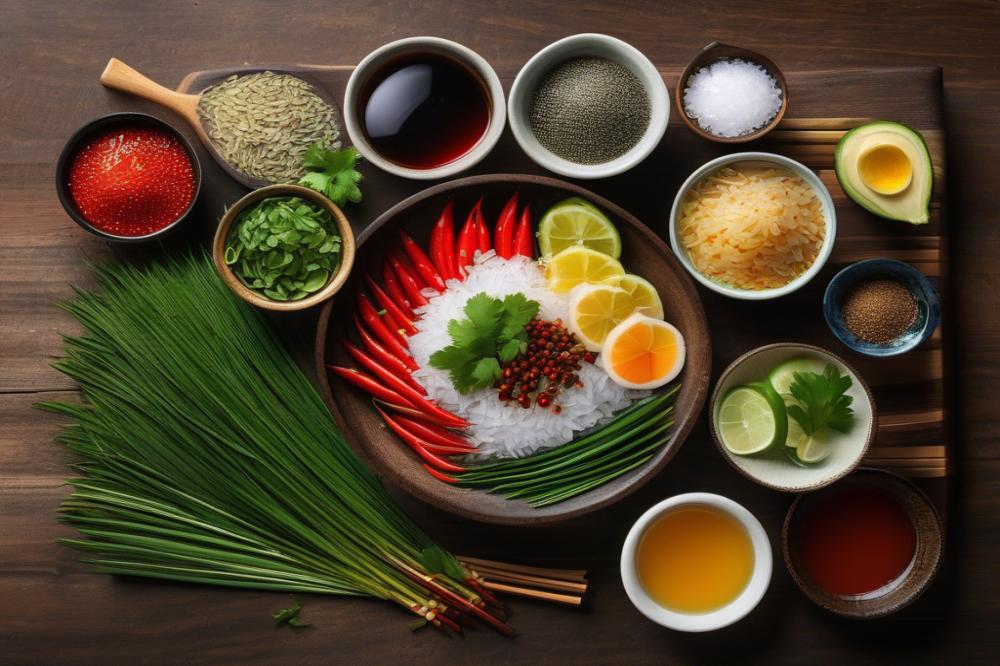Introduction to recipebix.com/vietnamese-fried-fish-cakes-cha-ca-recipe“>Vietnamese Fish Sauce Nước Mắm
Vietnamese Fish Sauce, or Nước Mắm, holds a special place in the heart of Vietnamese cuisine. This essential ingredient adds depth and flavor to countless dishes, making it a staple in every household. It is not merely a condiment; it embodies the rich culture and culinary traditions of Vietnam. Whether drizzled over a bowl of pho, mixed into a savory stir-fry, or served as part of a dipping sauce, this flavorful liquid enhances each meal.
Many recipes require this umami-rich sauce for the perfect taste. Dipping sauces often rely on nước mắm as a base, blending it with lime juice, garlic, and chilies for a harmonious flavor balance. Its versatility shines in various contexts, from enhancing seafood dishes to enriching noodle soups. Some might find it surprising how a single ingredient can transform the mundane into something memorable.
The traditional methods of making fish sauce are as intriguing as its applications. Crafting homemade nước mắm involves fermenting fish, usually anchovies, with salt over time. This process can take several months, allowing the flavors to develop fully. The fermentation creates a complex profile that is simply unrivaled. Mastering this age-old technique unlocks the door to authentic flavors and textures in Asian cuisine. Understanding these practices provides deeper insight into why this sauce is so revered.
What is Vietnamese Fish Sauce

Vietnamese fish sauce, known as nước mắm, is a flavorful liquid made from fermented fish. It serves as a key ingredient in many dishes. The process of making this sauce involves the fermentation of fish, traditionally anchovies, with salt. Over time, the fish breaks down, creating a rich and complex flavor profile. This sauce is often used in cooking and as a dipping sauce, enhancing the taste of various foods.
Historical Background and Origins
Nước mắm has a long-standing history in Vietnam. Its origins trace back thousands of years, with roots in Southeast Asian culinary traditions. Fishermen once produced this sauce as a means of preserving their catch. Over generations, this practice evolved into an art form. It became a staple in Vietnamese households and a significant aspect of the country’s cuisine.
Differences from Other Asian Fish Sauces
While Asian cuisine features several types of fish sauces, Vietnamese versions stand out. They are often lighter in color and more aromatic than those found in Thailand or the Philippines. The fermentation process is unique to the region, resulting in a distinct flavor profile. Vietnamese fish sauce tends to have a smoother taste, with a pleasant balance between saltiness and sweetness.
Umami and Its Significance in Flavor Profiles
Umami plays a vital role in the appeal of Vietnamese fish sauce. This taste, often described as savory, enhances dishes and creates depth in flavors. Foods that are high in umami, like seafood and meats, benefit greatly from the addition of nước mắm. Home cooks often highlight this sauce in their recipes to bring out the best in each meal. Its rich umami flavor can transform simple ingredients into something exceptional.
Ingredients List and Cooking Instructions

To create traditional fish sauce, gather the following ingredients. Fresh fish is crucial for flavor. Anchovies are preferred for their rich taste. You will need 1 kg of fresh fish and 300 g of sea salt. The salt acts as a preservative and enhances the flavor. Additionally, set aside 500 ml of water for dilution.
Cooking Instructions
Start by preparing the fish. Rinse them gently under cold water. After cleaning, combine the fish with salt in a large bowl. This mixture will begin the fermentation process. Next, layer the fish and salt in a fermentation container. A glass jar or ceramic pot works well. The layers should be packed tightly to prevent air pockets.
Once layered, pour in the water to cover the fish completely. This step is vital. It helps extract flavors during fermentation. Cover the container loosely with a lid or cloth. Ensure it is kept in a cool, dark place. This environment encourages the growth of beneficial bacteria.
Fermentation will take time. Let the mixture sit for about 6 to 12 months. The exact duration can vary based on the temperature and humidity. You may notice a strong aroma developing, which indicates that it’s working. After this time, check the flavor. Once it reaches a pleasing umami taste, it’s ready to be extracted.
To extract the sauce, strain the liquid using a fine mesh sieve. Collect the liquid in another container, discarding any solids. Store the fish sauce in clean, sterile bottles. Keep it in a cool place or refrigerated for optimal freshness. This homemade condiment adds depth to dishes or can be used as a dipping sauce.
Nutritional Information
Let’s look at the nutritional benefits of these key ingredients. Fish is an excellent source of protein. It also contains omega-3 fatty acids, which are essential for heart health. Consuming fish contributes to overall well-being.
Sea salt provides sodium, an essential mineral. It plays a crucial role in preserving the fish sauce. Without salt, the sauce wouldn’t last long. Lastly, water aids in the overall healthiness of the sauce. Hydration is vital for balance in our diet.
The Fermentation Process

Understanding the fermentation process is central to making nước mắm. This technique involves breaking down the ingredients over time, which produces complex flavors. Fish and salt are the main ingredients. These are mixed and left to ferment in a controlled environment. Over weeks or months, the fish decomposes, and this is where magic happens.
Fermentation plays a crucial role in developing the umami flavor, which gives seafood dishes their savory depth. During this time, enzymes and bacteria transform proteins into amino acids. This change creates a rich taste that’s hard to replicate. As a result, the final product has a deep, flavorful profile that enhances many dishes.
Traditional Techniques
Traditional methods of fermentation often emphasize patience and care. Many families pass down recipes that include specific techniques to maximize flavor. Large barrels made of wood or ceramic may be used to hold the mixture. They often store these barrels outdoors, allowing nature to influence the process. This version can take anywhere from six months to two years to be ready.
Modern Techniques
In contrast, modern methods may speed things up. Some commercial production facilities use controlled environments to shorten the fermentation time. This approach can produce fish sauce in just a few weeks. While faster, it may lack the depth of flavor found in traditional varieties.
Factors Influencing Quality
Several factors affect the quality of the final product. Temperature plays a significant role; warmer climates can speed up fermentation. The salt concentration is also important. Too much salt can slow down the process, while too little can spoil the mixture. Different types of fish can impact the flavor as well. Anchovies are commonly used due to their rich taste.
Finally, monitoring the fermentation duration is essential. Homemade batches require patience and periodic taste tests. Regularly checking can help identify the perfect moment when flavors are balanced. Producing high-quality fish sauce requires both art and science. From cooking to using it as a dipping sauce, the careful fermentation creates a product cherished in Asian cuisine.
Uses of Vietnamese Fish Sauce

Fish sauce serves many purposes in cooking. It adds depth and flavor, enhancing dishes with its salty and savory notes. Many cooks appreciate its ability to bring out the umami flavor in recipes. Using it can transform a simple meal into something delightful.
Popular Recipes That Incorporate Nước Mắm
Numerous dishes feature this traditional ingredient. Rice dishes often benefit from a splash of fish sauce. Stir-fries, whether with vegetables or meat, can become more flavorful with just a bit added. Soups, such as phở, rely on this sauce to deepen their taste. Marinades also become richer when they include fish sauce, especially for chicken and beef.
As a Dipping Sauce
Dipping sauces often highlight the versatility of fish sauce. It pairs wonderfully with seafood, providing a salty contrast to the sweet and tender flesh of shrimp or fish. Spring rolls also shine when served with a sauce that has fish sauce in the mix. For salads, a dressing that includes fish sauce adds zing and excitement, making even a simple dish feel gourmet.
Balancing Flavors
When using fish sauce, it’s key to balance flavors. Too much can overpower a dish. Many chefs recommend tasting as you go to find the right amount. Adding sweetness, like sugar or honey, can soften the salty notes. Acidic ingredients, such as lime or vinegar, contrast nicely with fish sauce, creating a well-rounded flavor profile. Remember, it’s about harmony in the final dish.
Homemade fish sauce opens up a world of possibilities. The fermentation process allows various flavors to develop, making it distinct. Each batch can vary, providing a unique flavor experience depending on the ingredients used. For those eager to explore Asian cuisine, mastering the use of this sauce is essential.
Making Vietnamese Fish Sauce at Home
Advantages of Making Your Own Fish Sauce
Creating fish sauce at home offers several benefits. First, you can control the ingredients. Quality fish and salt can lead to a more flavorful result. Homemade versions often have fewer preservatives. This means you can enjoy a fresher product that complements dishes beautifully. Additionally, making your own allows for customization. If you prefer a stronger umami flavor, adjustments can be made during fermentation.
Comparison of Homemade Versus Store-Bought Versions
Store-bought fish sauce comes in many varieties, but they are not all the same. Many commercial brands include artificial additives. These can alter the taste and quality. In contrast, your homemade sauce will have a depth of flavor that pre-packaged options usually lack. Fermentation time can also vary greatly. While some store varieties might not undergo proper aging, your own creation will develop a richer profile over time.
Tips for Ensuring Quality and Avoiding Common Mistakes
Selecting the right ingredients is crucial. Use high-quality fish, preferably anchovies, for the best flavor. The right salt is also essential. Sea salt often works better than table salt. Fermentation takes patience. Keep your mixture in a warm, dark place for several months. Remember to taste throughout this process. It helps to monitor the flavor development. Also, avoid disturbing the fermenting sauce too much. Less handling can lead to a more balanced outcome.
Storage and Shelf-Life of Homemade Fish Sauce
Once you’ve created your fish sauce, proper storage maximizes its lifespan. A glass container works best to maintain freshness. Keep it in the refrigerator for up to a year. The flavor may continue to develop over time, so don’t worry if changes occur. Regular checks for off odors or unusual appearances are wise. As long as it smells and looks good, it’s likely safe for use.
The Essence of Nước Mắm
Vietnamese fish sauce holds a vital place in Asian cuisine. It elevates many dishes with its distinctive flavors. This ingredient is a balance of umami, salt, and sweetness, making it a beloved staple in kitchens across the continent. Knowing how to make your own version can deepen your appreciation for authentic dishes. The satisfaction of crafting such a traditional component at home is unmatched. It allows for a connection to centuries of culinary history.
Experimenting with a homemade recipe opens doors to new possibilities. You can use it to enhance everything from stir-fries to marinades. The way it transforms simple meals into vibrant feasts is truly remarkable. Each drop carries a story of culture and tradition, inviting you to explore more. Embrace the bold flavors and let your creativity shine. Use this sauce in various dishes to discover its versatility.
So why not take the plunge? Making your own version can be rewarding and enjoyable. Whether you prefer a lighter flavor or a richer taste, the journey is worth it. By experimenting with different ingredients, you’ll find what suits your palate best. Dive into the world of Vietnamese fish sauce and enjoy the rich tapestry of flavors it brings to your meals.



